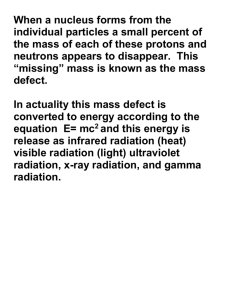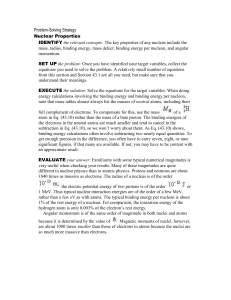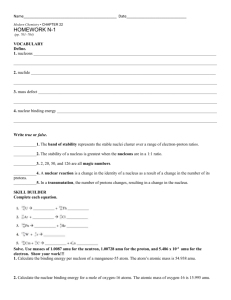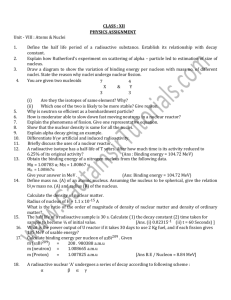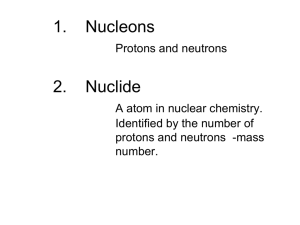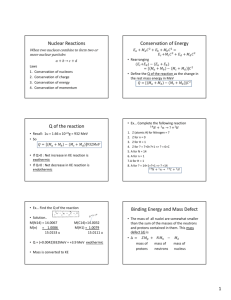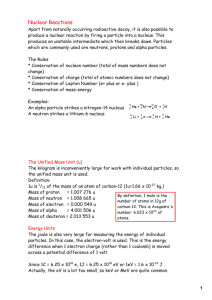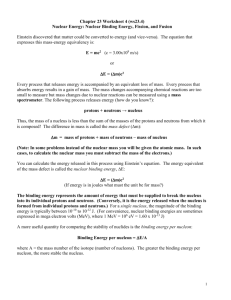Nuclear Binding Energy
advertisement
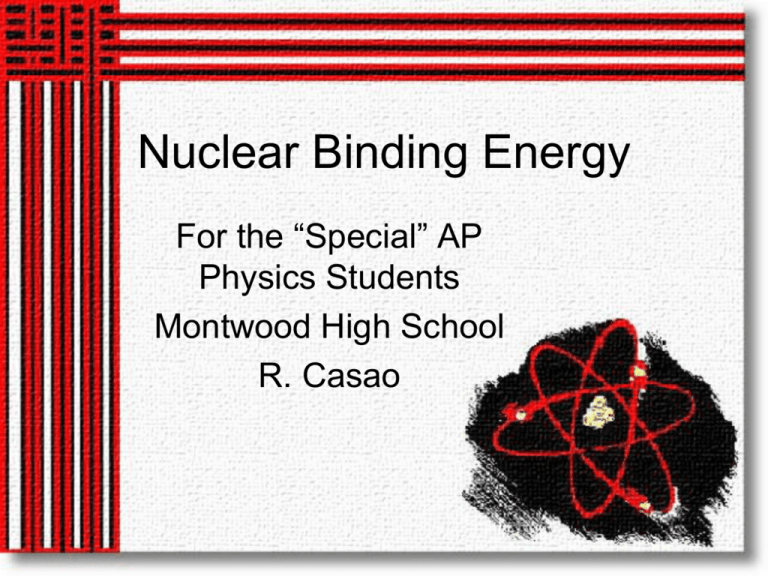
Nuclear Binding Energy For the “Special” AP Physics Students Montwood High School R. Casao Nuclear Binding Energy • Energy must be added to a nucleus to separate it into its individual nucleons (protons and neutrons). • The energy that must be added to separate the nucleons is called the binding energy EB. • The binding energy is the energy by which the nucleons are bound together. Nuclear Binding Energy Einstein and Energy • Einstein determined that matter could be thought of as a form of energy and that there would be a quantity called "rest energy" which would be the amount of energy that composed a piece of matter. • This rest energy can be determined by E = m·c2, where m is the mass at rest. • Einstein’s equation not only says that mass and energy are equivalent to each other with the speed of light as a conversion factor, but that energy and mass are interchangeable between each other. In other words, mass is a form of energy. Mass Defect • The total mass of the nucleons (the individual protons and neutrons) is always greater than the mass of the nucleus by an amount EB called the mass defect. c 2 • The mass defect is the mass of the individual nucleons minus the mass of the nucleus. • The mass defect represents the mass that is converted to binding energy. Nuclear Binding Energy • The nuclear binding energy for a nucleus containing Z protons and N neutrons is: EB (Z MH N mn A ZM A 2 Z M) c where is the mass of the neutral atom containing the nucleus, the quantity in the parenthesis is the mass defect, and 931 .5 MeV c u 2 Nuclear Binding Energy • Note that the equation does not include Z·mp, the mass of Z protons. • The equation contains Z·MH, the mass of Z protons and Z electrons combined as a 1 H atom to balance the Z 1 neutral A electrons included in M, the mass of Z the neutral atom. • The Table of Atomic Nuclides contains the atomic masses of nucleons and atoms in atomic mass units, u. • Nuclear masses are measured in terms of atomic mass units with the carbon-12 nucleus defined as having a mass of exactly 12 u. • Conversion to u: 27 1 u 1.66054 x 10 kg 931.5 MeV • 1 eV = 1.602 x 10-19 J • It is also common practice to quote the rest mass energy Eo=mo·c2 as if it were the mass. Binding Energy of a Deuteron • The simplest nucleus is hydrogen, a single proton. 2 • Next comes the nucleus of 1 H, called deuterium. It’s nucleus consists of a proton and a neutron bound together to form a particle called a deuteron. • The binding energy of the deuteron: MeV E B (1.007825 u 1.008665 u 2.014102 u) 931 .5 u Binding Energy of a Deuteron • EB = 2.224 MeV • This is the amount of energy that would be needed to pull the deuteron apart into a proton and a neutron. • An important measure of how tightly a nucleus is bound together is the binding energy per nucleon: E B A Binding Energy of a Deuteron • A is the mass number. • Binding energy per nucleon: 2.224 MeV 1.112 MeV / nucleon 2 nucleons • 2 1 H has the smallest binding energy per nucleon of all nuclides. • The higher the binding energy/nucleon, the more stable the nucleus. Binding Energy Comparison • The enormity of the nuclear binding energy can be better appreciated by comparing it to the binding energy of an electron in an atom. • The comparison of the alpha particle binding energy with the binding energy of the electron in a hydrogen atom is shown on the next slide. • The nuclear binding energies are on the order of a million times greater than the electron binding energies of atoms. Binding Energy Comparison Binding Energy/Nucleon • Most stable nuclides, from the lightest to the most massive, have binding energies in the range of 7 to 9 MeV/nucleon. • A graph of binding energy per nucleon as a function of mass number A shows a spike at A = 4, showing the unusually large binding energy per nucleon of the 4 2 He nucleus (alpha particle). Binding Energy/Nucleon Binding Energy/Nucleon Binding Energy/Nucleon • The fact that there is a peak in the binding energy curve in the region of stability near iron means that either the breakup of heavier nuclei (fission) or the combining of lighter nuclei (fusion) will yield nuclei which are more tightly bound (less mass per nucleon). The Strong Nuclear Force • The force that binds the protons and neutrons together in the nucleus, despite the electrical repulsion of the protons, is an example of the strong nuclear force. • Characteristics: – Does not depend on charge; neutrons and protons are bound and the binding is the same for both. – Short range; about 10-15 m. Within this range, the nuclear strong force is greater than the electrical force of repulsion. The Strong Nuclear Force – Physicists still do not fully understand the dependence of the strong nuclear force on the separation r. – The nearly constant density of nuclear matter and the nearly constant binding energy per nucleon of larger nuclides show that a particular nucleon cannot interact simultaneously with all the other nucleons in a nucleus, but only with those directly around it. – This is different from the electrical force; every proton in the nucleus repels every other proton in the nucleus. The Strong Nuclear Force – The nuclear strong force favors binding of pairs of protons or neutrons with opposite spins and of pairs of pairs (a pair of protons and a pair of neutrons, each having opposite spins). This is why the alpha particle (two protons and two neutrons) is a stable nucleus. Equations 2 • Mass-Energy Relationship: E Δm c E = energy, m = mass converted to energy or energy converted to mass, c = 3 x 108 m/s • Mass defect: number of protons x amu proton number of neutrons x amu neutron mass of individual nucleons mass of nucleus mass defect amu proton = 1.007276 amu amu neutron = 1.008665 amu Equations • Nuclear Binding Energy: EB 931.5 MeV 1.602 x 10 13 mass defect (u) u MeV
